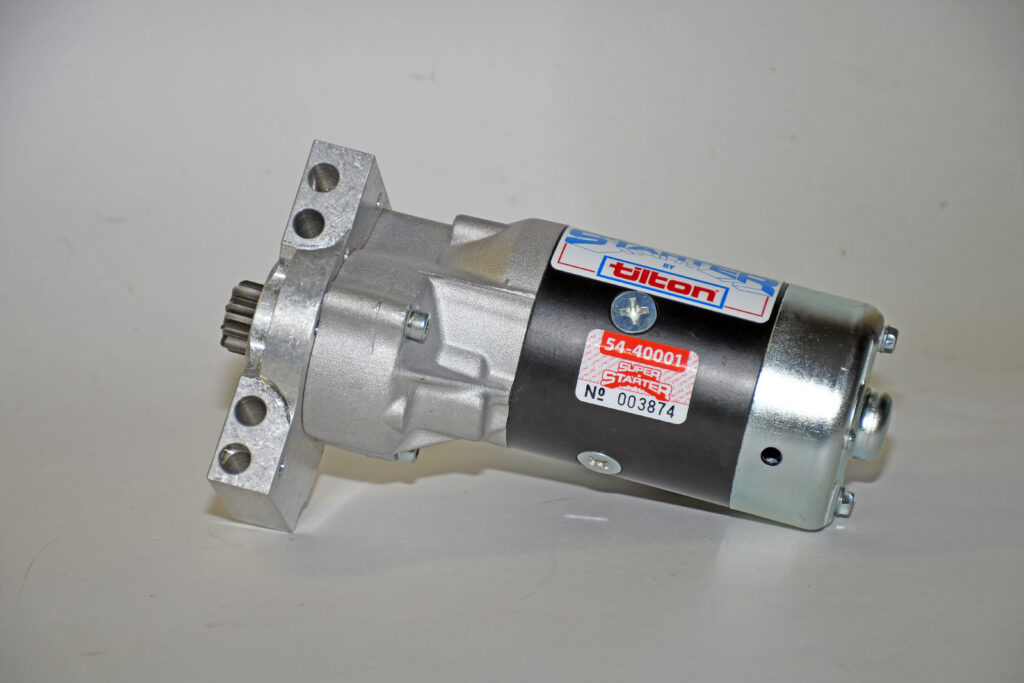

In our last issue, we began our look at Tilton Racing’s Super Starter (www.tiltonracing.com). If you point your browser back to that segment, you’ll see we looked at the reasons why a high-power gear reduction starter works and how Tilton packaged their system. We also looked at how powerful the Tilton Super Starter is (typically, they produce 3-HP and over 15.5 foot-pounds of torque). This time around, we’ll dig into the installation. What you see might surprise you because it’s easier than you think. Check it out:

Weight Savings & Installation…
As we pointed out in our last issue, in terms of overall size, it’s easy to appreciate the fact a Tilton Super Starter is considerably smaller than something like a vintage heavy-duty Delco starter. This small size allows for added exhaust clearance, added oil pan clearance and in some cases, added ground clearance. The added room allows for increased airflow around the starter, and that lessens the heat predicament. Just as important, these starters (which actually tip the scales at 12 pounds) work out to 10 pounds lighter than an aluminum nose Delco. Compared to an iron-nose Delco (such as the models used on countless vintage vehicles) or a big Chrysler gear reduction starter, the weight savings are even more considerable.

Electrical Hook Up….
What about installation? If you look closely, you’ll see that the Super Starter comes complete with a pair of mounting holes. By mounting the starter inward or outward, it can fit small and large diameter flywheels or flexplates. Adjustment for correct pinion mesh is also taken into consideration. Included with the starter are shims to move the pinion down and another set of shims to move the pinion out. We’ll examine the adjustment procedure later in the article. Mounting bolts are also included with the starter package.
How difficult is the wiring? If you have a look at the solenoid, you’ll see two threaded (8-mm) studs and one male spade (push on) terminal. The (+) battery cable attaches to the top stud and the starter switch wire goes to the spade terminal.

In some late sixties to early seventies GM applications with a stock point trigger distributor, an ignition resistor bypass is used. In this case, the wiring is the same, but a second wire from the distributor goes to the starter. The stock wire is usually yellow with a purple stripe. Connect the distributor wire to the lower 8-mm stud (closer to the starter motor body). A 10 amp, 12-volt diode will have to be spliced into this wire so that feedback voltage does not reach the starter. Although the diode isn’t supplied with the starter, Tilton advises that any 10 amp, 12-volt diode will work. If you have an aftermarket distributor or you have converted to electronic ignition, then the second wire with the diode isn’t required.
For applications such as a Ford or Mopar with a remote solenoid, Tilton advises you to connect the large positive lead from the remote solenoid to the top (unused) post on the starter solenoid. Then attach a small jumper wire (included with the starter) to connect the spade terminal to the starter solenoid post.

Engagement….
The folks from Tilton Racing offer this advice when installing the starter: “The relationship between the starter pinion and the ring gear is important for proper operation. Due to the starter’s high operating torque, failure to install correctly will usually result in starter or ring gear damage.”
So how is that accomplished? According to Tilton, the starter pinion to ring gear clearance must be 0.100-inch (+ or – 0.40-inch). You should check this several times at different flywheel/flexplate locations (this is in the event the ring gear isn’t running true). Tilton notes if the pinion is too close, you must add the pinion shaped shim and the round shim (included with the starter). These shims move the pinion 0.062-inch away from the ring gear.
You must also measure the depth of pinion engagement in the ring gear. There must be 0.010-inch to 0.030-inch backlash between them. Tilton notes this can be checked with a wire gauge (for example, you can use a typical paper clip which measures approximately 0.030-inch). Hold the starter pinion in the engaged position at the ring gear. This is easily accomplished with a small prybar or with a flat blade screwdriver. If the fit is too tight, simply install the rectangular shim between the starter mount surface and the cylinder block.
Most Tilton 40000 series starters can also be indexed. What this means is, you can rotate the starter body in relation to the nose. This provides for more solenoid clearance for things like oil pans with larger kickouts or applications where there is cylinder block interference.

What Fits?
So far so good, but what fits what? High torque Tilton Super Starters are readily available for almost all Chevy applications. They offer starters that fit all big and small blocks as well as LS engines with 153 and 168 tooth ring gears. They also offer starters for Ford small blocks, Ford FE engines, Cleveland, and 429-460 engines. Some Chevy starters are available for reverse rotation engines (for example, something you might find in an offshore marine application) along with starters for specific Porsche’s and VW-style transaxles. Additionally, there are a number of starters in their catalog designed to work with bellhousing starter mounts.
The Bottom Line…
In the end, you’ll find that Tilton’s Super Starters aren’t frazzled by large displacement, high compression, heat or cold. They’re light, small, provide more header and oil pan clearance and just as important, they’re absolutely consistent from a starting perspective. For a daily-driven and modified hot rod or a dedicated race car, that could prove to be the most important asset. For a closer look, check out the accompanying photos:


Leave a Reply